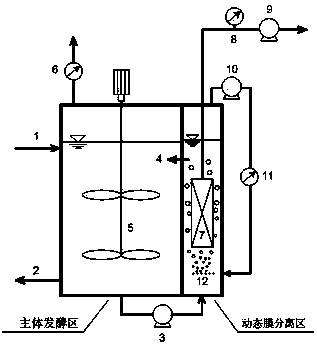Dynamic membrane forming control method applicable to anaerobic digestion of excess sludge
A technology of excess sludge and anaerobic digestion, applied in sludge treatment, biological sludge treatment, waste fuel, etc., can solve problems such as poor solid-liquid separation, high replacement cost, and damage to dynamic membranes, and achieve gas saving Circular energy consumption, convenient upgrading and transformation, and the effect of reducing damage
- Summary
- Abstract
- Description
- Claims
- Application Information
AI Technical Summary
Problems solved by technology
Method used
Image
Examples
Embodiment 1
[0024] use figure 1 The process shown treats residual sludge from municipal sewage treatment plants. It is composed of the main fermentation area and the dynamic membrane separation area, of which the effective volume of the latter is only 3% of the former. The main fermentation area is equipped with mud inlet pipe 1, mud discharge pipe 2, stirring device 5 and gas metering device 6; the dynamic membrane separation area is equipped with dynamic membrane module 7, pressure gauge 8, water outlet pump 9 and biogas circulation system, the biogas The circulation system is composed of a diaphragm vacuum pump 10, a gas flow meter 11 and a biogas diffusion pipe 12; the two areas are connected by a sludge return pump 3 and a sludge return pipe 4. The remaining sludge enters the reactor system from the sludge inlet pipe 1, and is stirred and mixed by the stirring device 5 in the main fermentation area; the sludge in the main fermentation area enters the dynamic membrane separation area...
Embodiment 2
[0027] use figure 1 The process shown treats residual sludge from municipal sewage treatment plants. The sludge concentration (SS) of the sludge inlet is 5-8 g / L, and the sludge concentration (SS) of the dynamic membrane separation zone is 18-22 g / L. The dynamic membrane module 7 adopts a polyester mesh module with a pore size of 39 μm and a membrane area of 0.038 m 2 , the membrane flux is 15 L / (m 2 · h), using continuous membrane filtration to operate. Using the invented method to operate, in a biogas cycle cycle, the closing time of the biogas circulation is 20 minutes, the opening time is 3 minutes, and the biogas circulation intensity is 25 m 3 / (m 2 h). The turbidity of the effluent is less than 150 NTU, the SS of the effluent is less than 120 mg / L, and the physical cleaning cycle of the dynamic membrane module is 5-10 days.
Embodiment 3
[0029] use figure 1 The process shown treats residual sludge from municipal sewage treatment plants. The sludge concentration (SS) of the sludge inlet is 5-8 g / L, and the sludge concentration (SS) of the dynamic membrane separation zone is 18-22 g / L. The dynamic membrane module 7 adopts a polyester mesh module with a pore size of 39 μm and a membrane area of 0.038 m 2 , the membrane flux is 15 L / (m 2 · h), using continuous membrane filtration to operate. Using the invented method to operate, in a biogas cycle cycle, the closing time of the biogas circulation is 20 minutes, the opening time is 1 minute, and the biogas circulation intensity is 50 m 3 / (m 2 h). The turbidity of the effluent is less than 160 NTU, the SS of the effluent is less than 140 mg / L, and the physical cleaning cycle of the dynamic membrane module is 7-20 days.
PUM
| Property | Measurement | Unit |
|---|---|---|
| Aperture | aaaaa | aaaaa |
| Membrane area | aaaaa | aaaaa |
Abstract
Description
Claims
Application Information
 Login to View More
Login to View More - R&D
- Intellectual Property
- Life Sciences
- Materials
- Tech Scout
- Unparalleled Data Quality
- Higher Quality Content
- 60% Fewer Hallucinations
Browse by: Latest US Patents, China's latest patents, Technical Efficacy Thesaurus, Application Domain, Technology Topic, Popular Technical Reports.
© 2025 PatSnap. All rights reserved.Legal|Privacy policy|Modern Slavery Act Transparency Statement|Sitemap|About US| Contact US: help@patsnap.com

